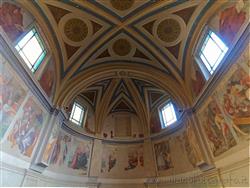|
Church of Sant'Ambrogio ad Nemus
|
|
|
Show an other treasure of art and history in Milan:
|
 Mostly represented styles: Baroque - Art - Nouveau Mostly represented styles: Baroque - Art - Nouveau
HISTORY
Although the current church is much more recent, the history of the place is very old, reaching up to the fourth century. At that time it seems that there arose a chapel in the woods (from which "ad nemus"), accompanied by some rooms, where Sant'Ambrogio went to meditate.
In fact it seems to be historically established that here the first monastery of history was founded, by St. Martin in 357 after Christ. According to the legend Saint Martin from Tours, driven out of Milan by the will of the Arian bishop Absinthe, took refuge in this area already before the dedication to Ambrogio, in 358.
After having survived the barbarian invasions, during the thirteenth and fourteenth centuries the small hermitage acquired more and more importance, becoming the seat of a religious order, that of the Friars of Sant'Ambrogio ad Nemus. Following the recognition by Pope Gregory XI in 1377 there was a first renewal of the church. A second occurred in 1500 by order of Ludovico Sforza.
In 1635 the ceiling of the church collapsed and the repair works led to radically alter the original lines: the floor of the presbytery and of the choir was raised as also the side walls to open larger windows.
In 1644 the order of Sant'Ambrogio ad Nemus was suppressed and the church passed to the Franciscan friars.
In the Napoleonic era the church was requisitioned and turned into a cartridge factory and ammunition deposit. The altars and the floor were destroyed and the plaster (and the frescoes that were present on it) was removed up to two meters in height.
The works of art kept in the church took the way of France, with one exception, the Pala Sforzesca, a painting in tempera and oil on wood panel made in 1494 by an anonymous artist active in Lombardy between 1490 and 1520, known precisely as "master of the Sforza Pala". The painting is now kept in the Pinacoteca of Brera.
On 29 August 1813 the uninhabited complex of Sant'Ambrogio ad Nemus became the seat of the Fatebenesorelle hospital. In 1840, however, they migrated to a new and larger building and the hospital of Sant'Ambrogio ad Nemus became a Relief House, an isolation hospital for cholera sick.
In 1852 the use of the complex changed again, becoming a nursery and rest house for elderly priests.
In 1857 the church passed to Don Luigi Guanella, canon from Como, who bought the entire complex in order to use it for charity and social security works for children and sick: this was how the Milanese Piccolo Cottolengo was born.
Towards the end of the nineteenth century the church was lengthened by 10 meters on a project by U. Stacchini, the architect of the Central Station. Also the façade was rebuilt, but it then changed again in 1928, when it was rebuilt in a style that wanted to emulate the fifteenth century style.
STRUCTURE
The church of Sant'Ambrogio ad Nemus is currently inside a courtyard. The façade has a single entrance and is divided into two orders surmounted by a large trinagular pediment. In the upper one there are three frescos by Eliodoro Còccoli of the Beato Angelico school.
The interiors include a single nave, in Art Nouveau style, corresponding to the Stacchini project. Very clear and slightly contrasted pastel colors dominate, with decorations composed by thin lines that intersect to form geometric patterns. Various chapels open on both sides. Some of them (four?) are from the first half of the seventeenth century and are characterized by vaults decorated with stuccos and frescoes. Others are evidently much more recent.
The first (flat) chapel on the left preserves in the upper part remains of Renaissance frescoes.
The ceiling is very particular, is flat and connected with the walls so as not to create edges.
The presbytery (not in line with the nave, but slightly oriented to the right) is also Art Nouveau. The altarpiece of the main altar, depicting the Virgin of Providence with the saints Ambrogio and Carlo, is a recent work by Costantino Grondona (Milan, 1891 - 1939).
In contrast to the presbytery, the apse still shows the segmented fourteenth-century structure and is much lower than the nave. In it there are frescoes of 1619 which, through 10 panels, narrate episodes of the life of Saint Matronianus Hermit and the discovery of his body.
The bell tower, not visible from the part of the church where you enter because of its small size, is a typical work of the Middle Ages, in pure Romanesque style, bult between the end of the X century and the beginning of the XI. It is placed, as was generally used at that time, next to the choir. It certainly must have been shortened in height for unknown needs.
From the church it is possible to access the fourteenth-century cloister on its right, characterized by original granite columns and pointed arches on three sides.
If you are interested in a guided tour of this monument send an email!
Categories: Churches / Religious buildings
Via Peschiera, 2-6, 20154 Milano MI |
Further pictures of the Church of Sant'Ambrogio ad Nemus in the section Photography |